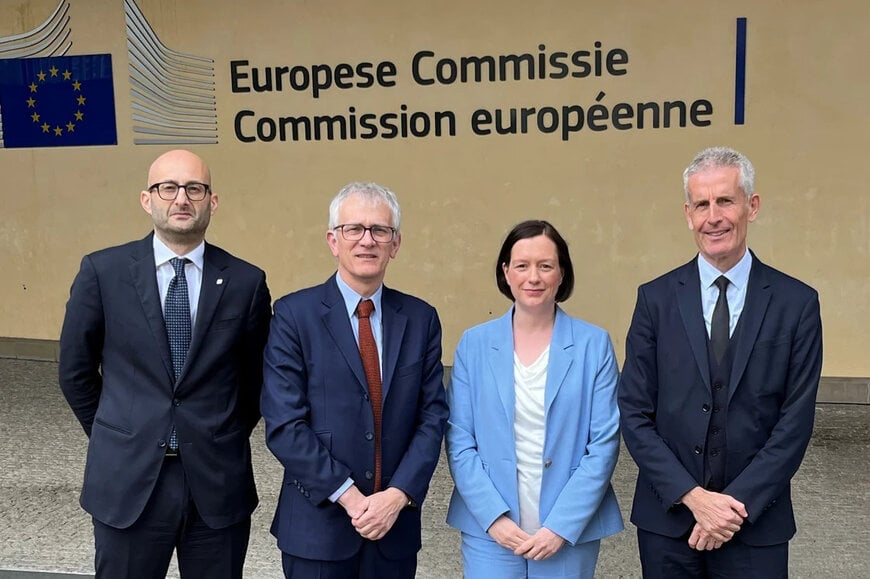railway-international.com
16
'25
Written on Modified on
European Rail CEOs join high-level Dialogue on continent-wide high-speed rail implementation
Senior leaders and the Executive Director from CER participated in the European Commission's Implementation Dialogue on High-Speed Rail, hosted by the Commissioner for Sustainable Transport and Tourism.
www.cer.be

Left to Right: Gianpiero Strisciuglio (CEO, Trenitalia), Alberto Mazzola (Executive Director, CER), Anja Schöllmann (Member of the Board, DB Fernverkehr AG), Alain Krakovitch (Director, SNCF TGV Intercités) | Photo credit: CER
Representing Europe's major railway operators, Gianpiero Strisciuglio, CEO of Trenitalia, Alain Krakovitch, Director of SNCF TGV Intercités, Anja Schöllmann, Member of the Board of DB Fernverkehr AG, and Alberto Mazzola, Executive Director of CER, joined the discussion to offer their expertise and support the rollout of a comprehensive and competitive European high-speed rail network.
European travellers increasingly want to travel by high-speed rail (HSR) because it offers a fast, comfortable, and sustainable way to reach their destination—whether for work, family, or leisure. HSR has proven to be inclusive and accessible, encouraging shifts from road and air to rail. It also relieves capacity on conventional lines, freeing space for freight, regional, and commuter services. When integrated with local and regional networks, HSR boosts overall public transport use and strengthens economic and social cohesion. With a well-connected HSR system, rail could capture up to 54% of the long-distance travel market by 2070, with positive spillovers benefiting conventional long-distance rail services as well.
CER members are actively contributing to the dialogue by sharing operational experience and insights on the steps needed to turn Europe's high-speed rail ambitions into reality. To deliver this vision, CER members are calling for coordinated European action in several key areas starting with the construction of a real European High-Speed Network connecting capitals and major cities with speeds above 250 km/h for new lines and above 200 km/h for upgraded lines. These include accelerating cross-border interoperability (e.g. with standardised ERTMS deployment), making ticketing seamless (e.g with the Open Sales and Distribution Model (OSDM)), creating a level playing field (e.g. with VAT and energy taxes), and keeping costs reasonable. Crucially, the network's success depends on a sustainable funding strategy combining public investment with private financing tools such as Public-Private Partnerships (PPPs) and Regulatory Asset-based (RAB) models. Stable regulation, predictable revenue, and strong public-private cooperation are vital to closing funding gaps and building a resilient, accessible, and competitive high-speed rail network across Europe.
www.cer.be
Representing Europe's major railway operators, Gianpiero Strisciuglio, CEO of Trenitalia, Alain Krakovitch, Director of SNCF TGV Intercités, Anja Schöllmann, Member of the Board of DB Fernverkehr AG, and Alberto Mazzola, Executive Director of CER, joined the discussion to offer their expertise and support the rollout of a comprehensive and competitive European high-speed rail network.
European travellers increasingly want to travel by high-speed rail (HSR) because it offers a fast, comfortable, and sustainable way to reach their destination—whether for work, family, or leisure. HSR has proven to be inclusive and accessible, encouraging shifts from road and air to rail. It also relieves capacity on conventional lines, freeing space for freight, regional, and commuter services. When integrated with local and regional networks, HSR boosts overall public transport use and strengthens economic and social cohesion. With a well-connected HSR system, rail could capture up to 54% of the long-distance travel market by 2070, with positive spillovers benefiting conventional long-distance rail services as well.
CER members are actively contributing to the dialogue by sharing operational experience and insights on the steps needed to turn Europe's high-speed rail ambitions into reality. To deliver this vision, CER members are calling for coordinated European action in several key areas starting with the construction of a real European High-Speed Network connecting capitals and major cities with speeds above 250 km/h for new lines and above 200 km/h for upgraded lines. These include accelerating cross-border interoperability (e.g. with standardised ERTMS deployment), making ticketing seamless (e.g with the Open Sales and Distribution Model (OSDM)), creating a level playing field (e.g. with VAT and energy taxes), and keeping costs reasonable. Crucially, the network's success depends on a sustainable funding strategy combining public investment with private financing tools such as Public-Private Partnerships (PPPs) and Regulatory Asset-based (RAB) models. Stable regulation, predictable revenue, and strong public-private cooperation are vital to closing funding gaps and building a resilient, accessible, and competitive high-speed rail network across Europe.
www.cer.be

